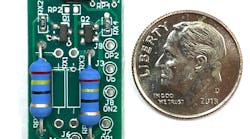Dual-Channel Plug-and-Play Solution Offers Supercap Balancing
Advanced Linear Devices Inc. (ALD) announced its precision dual-channel SABMBOVP2XX family of products, which automatically balance supercapacitors with the addition of overvoltage protection (OVP). The low power enables energy-efficient supercapacitor balancing that's well-suited for products requiring low-loss energy power, leakage current regulation, and OVP.
According to the company, it's a first-to-market plug-and-play solution targeting applications that require balancing, such as automotive, transportation, automation, data centers, and power grids.
Supercapacitor cells typically operate at a nominal recommended working voltage. However, voltages that exceed the maximum rating for a prolonged period will reduce cell operating life and eventually lead to failure. The nature of supercapacitors is that each has tolerance differences in capacitance value, internal resistance, and leakage current. When two or more supercapacitors are connected—either in a series or in parallel—these differences cause an imbalance in cell voltages that must be addressed through balancing so that no one cell exceeds its maximum rated voltage.
"The OVP board is the only commercially available balancing scheme that manages both overvoltage and leakage current," said Robert Chao, president and founder of ALD. "The circuit used on the board offers matched precision push-pull voltage/current action, which is ideal for cells with a minimal amount of energy loss."
ALD’s SABMBOVP2XX printed circuit boards (PCBs) include a plug-and-play feature, which enables sophisticated precision voltage-clamp circuits with high current gains. This combination is well-suited for balancing large supercapacitors that are stacked in a series, from two to hundreds of cells with values of 0.1 to 3000 F and beyond.
The SABMBOVP family has low output currents at input voltages that are below the threshold voltage when a drastic change in output current balancing is achieved through a sharp and steep change in the output current in response to small, incremental input voltages that are above the threshold voltage, and balancing occurs.
A critical design innovation of the family is that it has a high current gain (dl/dV = ~3 mA/1 mV) amplifier, which typically produces more than 1,000,000 times the output increase with very small increments of less than 100 mV in input change, claims ALD. By amplifying the output current, the voltage limits are reached quickly and efficiently to safely balance the supercapacitor. For example, a 33-mV input voltage change can alter the current from 1 to 100 mA.
The SABMBOVP specifically targets cells in which the charging/discharging currents can be up to 1000 A and charging at a few milliamperes will take too long to reach the supercapacitor’s voltage limits.
The SABMBOVP2XX PCB is populated with one of the company’s ALD9100XXSALI Supercapacitor Auto Balancing (SAB) MOSFETs, which specify the circuit threshold or clamping voltage to balance the circuit with near-zero charge loss. The balancing output current from the SAB MOSFET is amplified to produce (nominally) 1 mA of balancing output current at Vin, which is equal to the rated SAB MOSFET threshold.
The PCBs are designed to be compact, economical, and effective in balancing supercapacitors of any size. They're an energy-efficient solution for sensitive sensor circuits. The board, measuring a mere 0.6 x 1.6 in. (15.24 x 40.64 mm), operates in an industrial temperature range of -40 to +85°C. It's made with RoHS-compliant FR4 material and supplied ready for mounting a single ALD9100XX, eight-lead SOIC, says the company.
ALD also offers an unpopulated universal PCB for use with ALD9100xx Dual SAB MOSFETs. The boards can be cascaded to form a series-connected chain of boards to balance series-connected supercapacitors. The product family is in stock at Mouser and Digi-Key, with pricing starting from $15.42 each for a fully populated and tested board.

